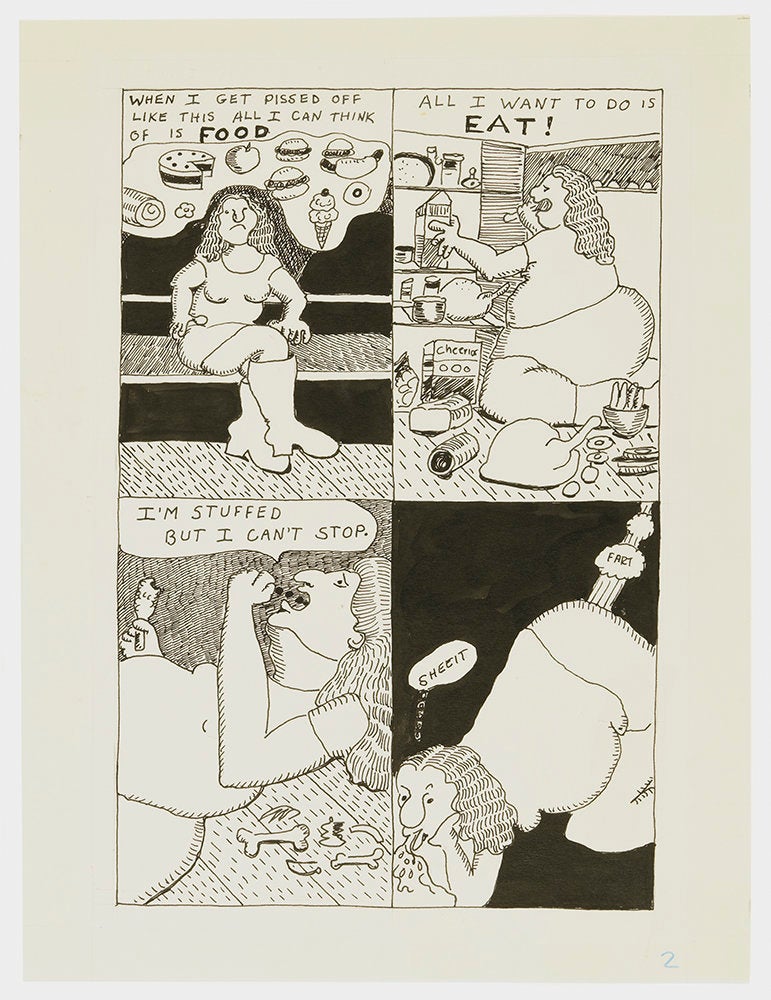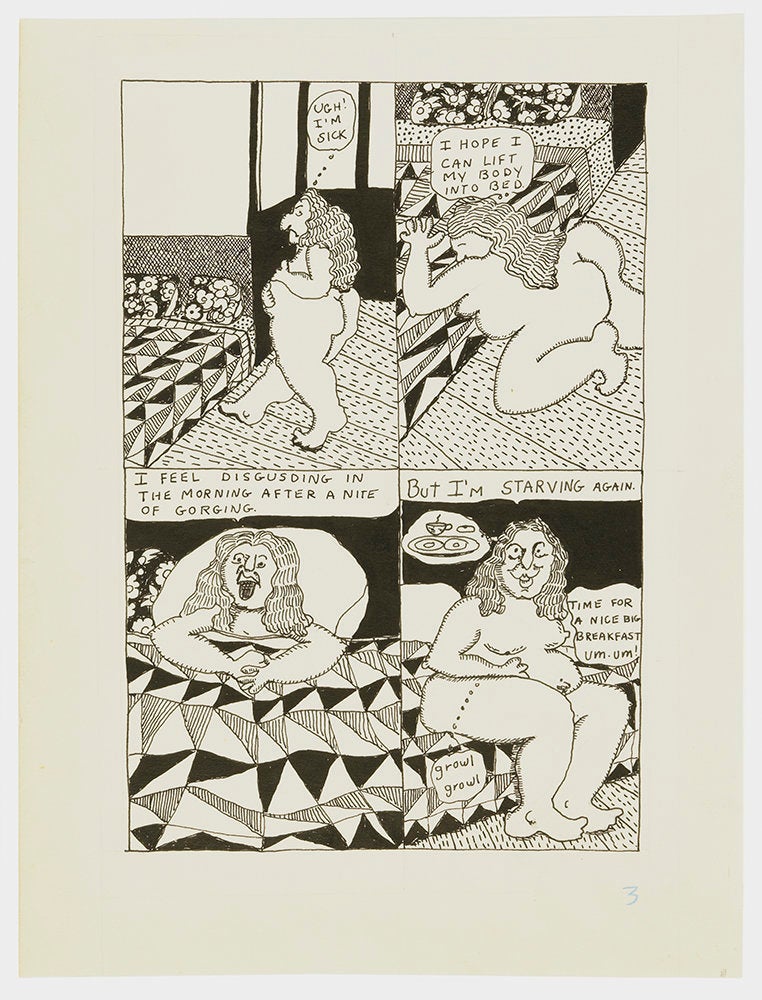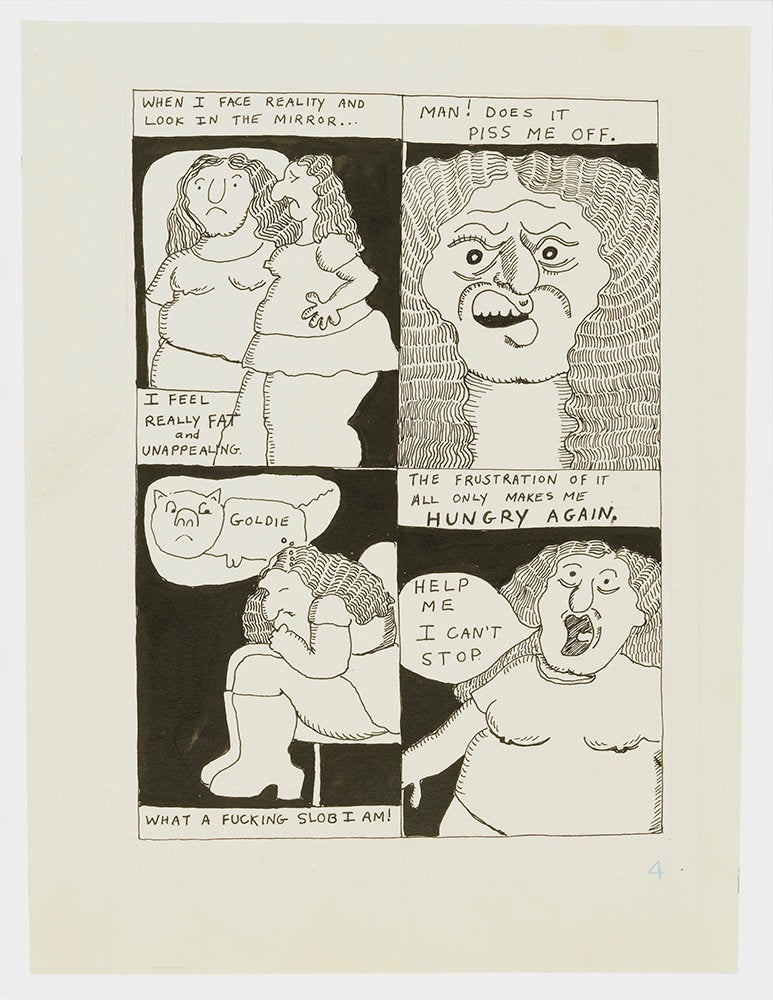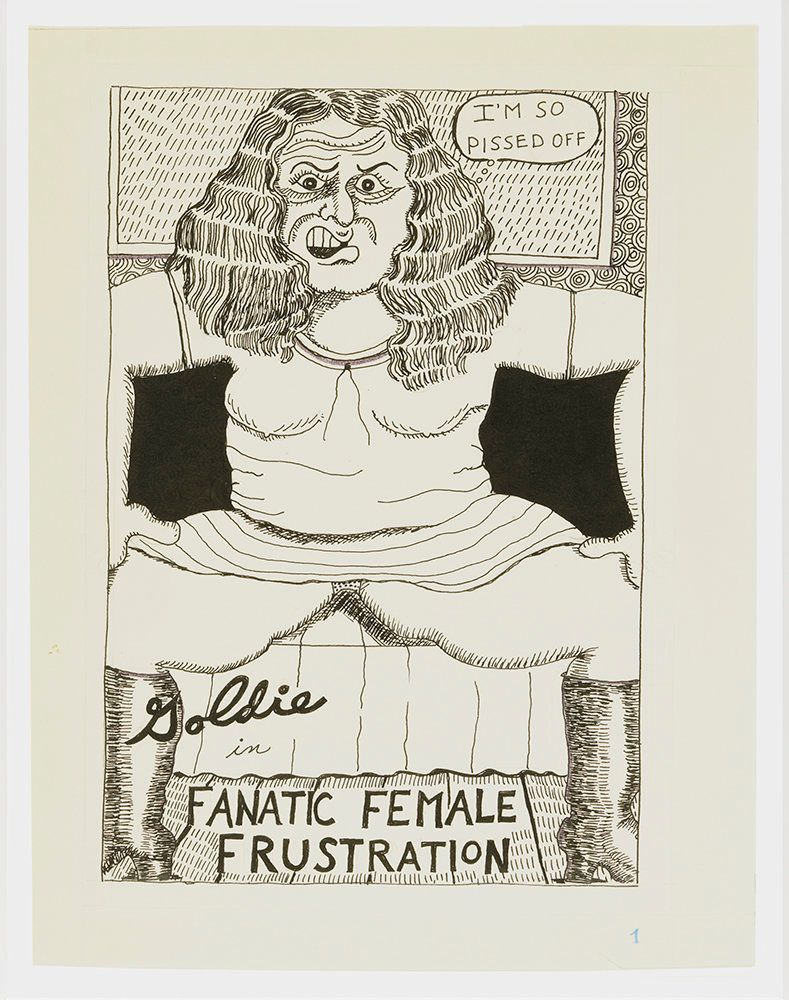“I’m so pissed off!” Goldie yells, sitting ― crotch out ― on the edge of her bed. She’s a wiggly, black-and-white drawing, comparably crude in appearance and personality, the creation of comic artist Aline Kominsky-Crumb.
When Kominsky-Crumb first drew “Goldie: A Neurotic Woman” in 1972, it was the first ever autobiographical comic made by a woman. And as a portrait, it was far from flattering. Instead, Kominsky-Crumb funneled her deepest insecurities, most embarrassing memories and most repulsive traits into her comic alter-ego, yielding a character who was self-loathing, vain, horny, ravenous and rude.
In one comic, Goldie kneels before her refrigerator, screaming to no one, “All I want to do is eat!” In the next panel she’s naked, lying prostrate on the floor, voraciously deconstructing a chicken leg with her mouth, pausing briefly to expel gas. In another, Goldie stares sheepishly at the viewer mid-masturbation, a moist carrot and cucumber resting at her side. “I’m fucked up. I know nobody does this,” reads the thought bubbling from her head.
It’s a breed of unapologetic, confessional humor that young women today might recognize in television shows like “Girls,” “Broad City,” or “Fleabag,” shows that make space for female characters who are sloppy, complex, sexual or, as they’re often described, “difficult.” But Kominsky-Crumb began working in the ‘70s, a time when there was no precedent for women comics whatsoever, let alone those who wished to break the rules.
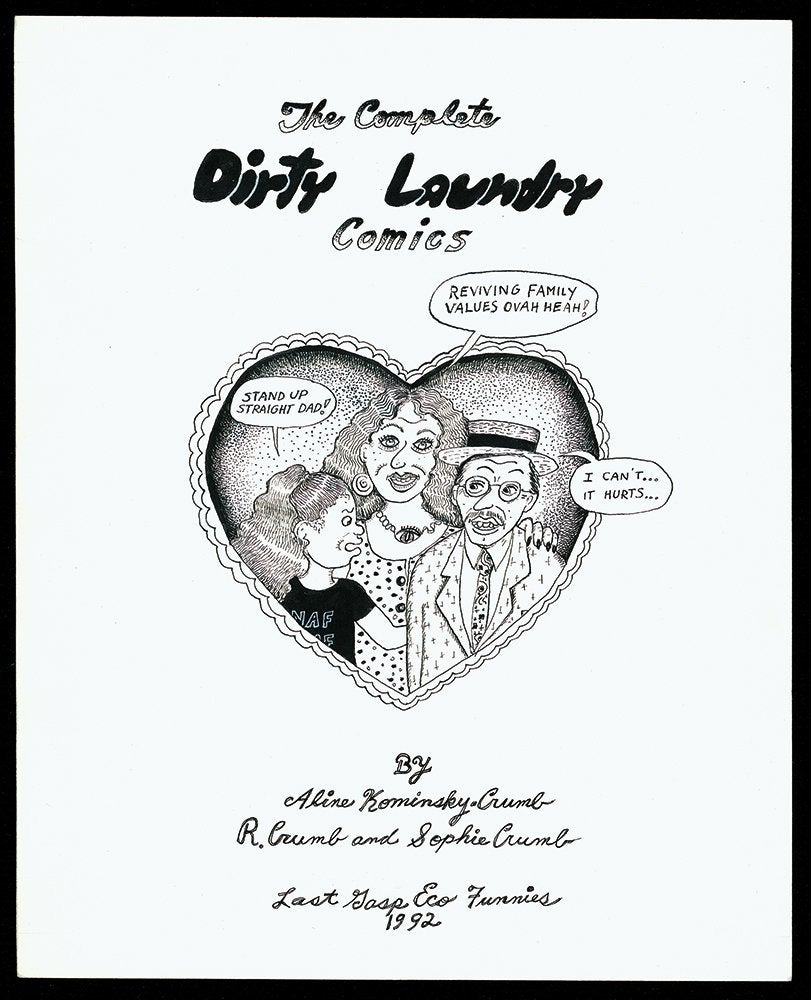
Kominsky-Crumb was born in 1948 to a Jewish family in Long Island, New York. After graduating high school, she attended the State University of New York at New Paltz and Cooper Union before getting a BFA from the University of Arizona. In the early ‘70s, she relocated to San Francisco, the flashpoint of underground comix where a male-dominated movement had emerged in response to the squeaky-clean censorship rules imposed on mainstream strips. The underground scene infused its graphics with sex, drugs and radical politics, but rarely included fleshed-out depictions of women.
Not long after Kominsky-Crumb moved to Northern California she met Robert Crumb, one of comic’s most worshipped luminaries, known for his meticulous aesthetic, self-deprecating wit and exaggerated perversity. They were introduced to one another by a mutual friend, who recognized how much one of Crumb’s fictional characters, “Honeybunch Kaminski,” resembled new-to-the-scene Aline.
The two hit it off, soon embarking on life as creative and romantic partners. Since 1974, they have collaborated on comics that relay the details of their daily lives. The decades-long collaboration has yielded a dense and dirty chronicling of the Crumbs’ married life, full of self-flagellating satire, libido that only grows with age, and a deep, freaky love that all artists and misfits will yearn for.
A retrospective of the couple’s work, called “Drawn Together,” is now on view at David Zwirner Gallery in New York, comprised of individual work from both Kominsky-Crumb and her husband, as well as combined efforts. While Crumb is well established in the fine art world for his artistic exploits, Kominsky-Crumb has yet to fully receive the credit she’s due.
For over 40 years, Kominsky-Crumb has chronicled agony and ecstasy through brutally honest portraits. A nasty woman to the core, she changed the game for women comics ― not to mention women comedians, authors and artists. In honor of her Zwirner exhibition, we reached out to Kominsky-Crumb to tell her story.
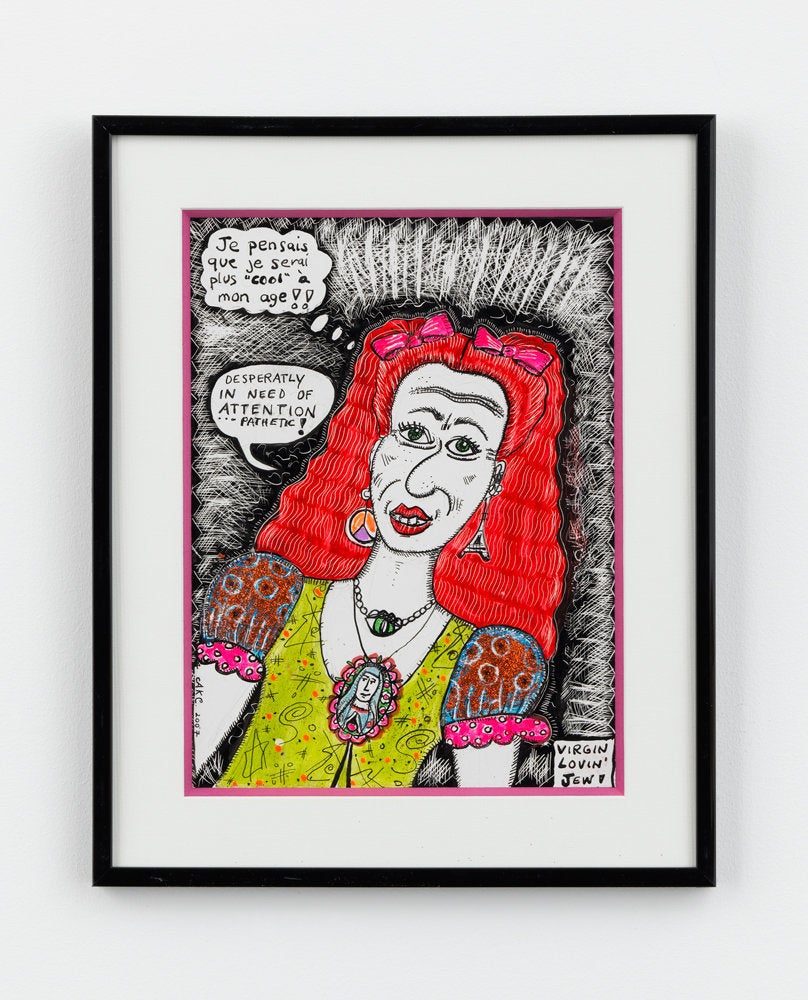
What was it like growing up in Long Island in the ‘50s? What was your family like?
My family was really barbaric. My father was a wannabe criminal. If he could have been a “Goodfella,” he would have. But he wasn’t Italian. He was Jewish. So he was a total loser. We lived in an affluent, very Jewish neighborhood but never had any money, so it was constant stress and torture. My parents had no patience for children, but I had very nice grandparents. I lived with them for the first five years of my life. They loved me and treated me like a princess, so in a way, I knew it wasn’t me — that there was something wrong. But for the most part, I was an outcast.
How would describe your personality as a kid?
I was depressed and frightened. So, because of that, I was the best student, behaved really well, and was constantly scared about what would happen if I did something wrong. When I was 8 years old, I realized my parents were not in control of anything, and I had to watch out for myself. I learned everything from reading and watching TV.
In general, I kept my ideas to myself and knew I had to get through school so I could get out of there. In high school I marked my days on the calendar like I was in prison. My town was all upward striving Jewish kids that all wanted to go to the best schools, all pretty spoiled and snotty. I’m sure there were other losers like me, but, generally speaking, I thought it was a horrible place. There was no creativity, it was all about making money and getting ahead.
Did art play a role in your life growing up?
I started drawing when I was young. I had a very nice art teacher who gave me a lot of validation, which I needed. When I was 14, I started going into Manhattan and looking at art. I realized, then, that there was some way to find joy and happiness in life. Before that, I thought life was pain and torture and discomfort and... more torture.
Do you remember which artworks, in particular, moved you?
There was a Latin American art show at MoMA and I saw a painting by Frida Kahlo that totally blew my mind. I really liked German Expressionist work too. Monet and Matisse ― all of it was mind boggling to me. I was turned on by everything. But Kahlo — the beauty, the suffering, the honesty, the autobiographical quality. I thought she was so much better than her husband and everyone else, really.
Were there arenas outside of the art world that you found inspiring?
Standup comedy. I was very influenced by a lot of Jewish standup comics in New York. Alan King. Jackie Mason. My grandfather was really into them.

How much time did you spend in the city as a teenager?
In the ‘60s I started sneaking into the Village and seeing all these hippies and weirdos ― people like me. The second I graduated high school, I left home, and life’s been getting better ever since.
What made you eventually leave New York?
Well, I went to Cooper Union for a while. And then I moved out to Arizona with a guy. We lived out in the desert, very psychedelic, took tons of drugs. It influenced me artistically a lot in terms of color. Helped me break down that middle class value system. I got a diploma from the University of Arizona and moved to San Francisco.
You got your bachelor’s degree in painting. What compelled you to pursue comics?
I realized I was more of a narrative artist than a visual artist. I wanted to tell stories about my childhood. Those are the stories I wrote about until like 20 years ago, they were all just about my family. These embarrassing, painful, incidents ― I was compelled to draw them. It was partly therapeutic, but, [laughs] I also went to therapy which probably was more effective. But I had to get the stuff out.
When you started making autobiographical comics, no one else was doing anything like that. Were you nervous to expose the embarrassing details of your life to the public?
It came naturally to me. I never thought about the fact that people would actually be looking at them until they actually came out. When I was working on something, it was just something I was really driven to express. I had to get it out. The fact that someone was willing to publish it was kind of amazing. I just dealt with the repercussions, I was never able to censor myself. I’m still like that. pretty much just comes out and I have to live with it.
Your comics revolve around a woman who is unapologetically insecure, grotesque, sexual and sometimes self-destructive. Is she you? A version of you?
She is made up of exaggerated parts of me that I blow up and push to the maximum. I drew the most sordid, unacceptable parts of myself. I’m not as ugly as I draw myself. But when I was younger, that’s how I felt, so that’s what I drew.
In retrospect, I thought I’d bring out the worst part of myself and see if people still loved me. I didn’t do it on purpose ― to shock ― but it was shocking to people. I did it because I needed the ultimate approval.
What comes first for you: the text or the drawing?
I’m very story-driven. Stories would stew in my head for a while and sometimes I wake up in the morning and write them down. I’m always narrative-driven, so mostly I just have to think about how to draw the things. I’m not a realistic drawer, so it was sometimes a struggle to make the world look real. Later I realized, it doesn’t have to look real, it just has to be legible.

San Francisco in the ‘60s was the hotbed of the underground comix scene. What drew you into this world?
I thought underground comics were the most interesting art form. They were completely irreverent, very personal, saying “fuck you” to everybody. I found the art establishment in New York to be pretty stifling at that time. Abstract expressionism, not very figurative, it was hard to tell a story. With comics, there was sex, there was feminism. And it was cheap ― meant to be read and thrown away ― the opposite of precious, fine art.
I wanted to do stuff that people like me could buy really cheap, read on the toilet and throw away. That appealed to me.
What was your first comic that got published?
I was very lucky. I arrived in San Francisco when the first edition of “Wimmen’s Comix” was getting put together. There were no women comics, so they would put anything in their book. So the first comic book I appeared in was “Wimmen’s Comix 1.”
Wimmen’s Comix was an all-women publication that tackled issues including abortion, rape, suffrage and queer life. How important was feminist ideology to you during this time of your life?
The group of women I got involved with were rabid feminists, so I was forced to define how I felt abut those issues when I joined the group. There were two factions: militant feminists who wanted nothing to do with men and women who wanted to be strong and independent but sexy too. That’s who I aligned with.
The possibility of really having fun appealed to me at that time in my life. Sex was too much fun, I didn’t want to give it up. I liked to dress up, go to parties. I was wild and bad. I didn’t want to give that up either. So I controlled my life. I worked. I wasn’t anybody’s dupe. But I could have a lot of sex if I wanted to. I was very conscious of the entire feminist movement, but I realized there was an extreme part of it I couldn’t relate to.
This is also around when you met Robert Crumb?
I met Robert right when I went to San Francisco. I thought he was great. I couldn’t even imagine reaching his level, it seemed like another world. When I met him, he didn’t know I did comics, and I didn’t tell him until one got published. When I showed him he laughed so hard he fell to the ground and that made me like him.
Did you notice a difference in how your work was received?
I was judged very harshly when I started working with Robert. He had really loyal fans and I got a lot of hate mail.
Did you feel any pressure or pull, urging you to change your style, to make it more like his?
I am not capable of it. It’s not really a question. I thought the contrast of our drawing styles was interesting together. Mine is very flat and Robert is very three-dimensional.
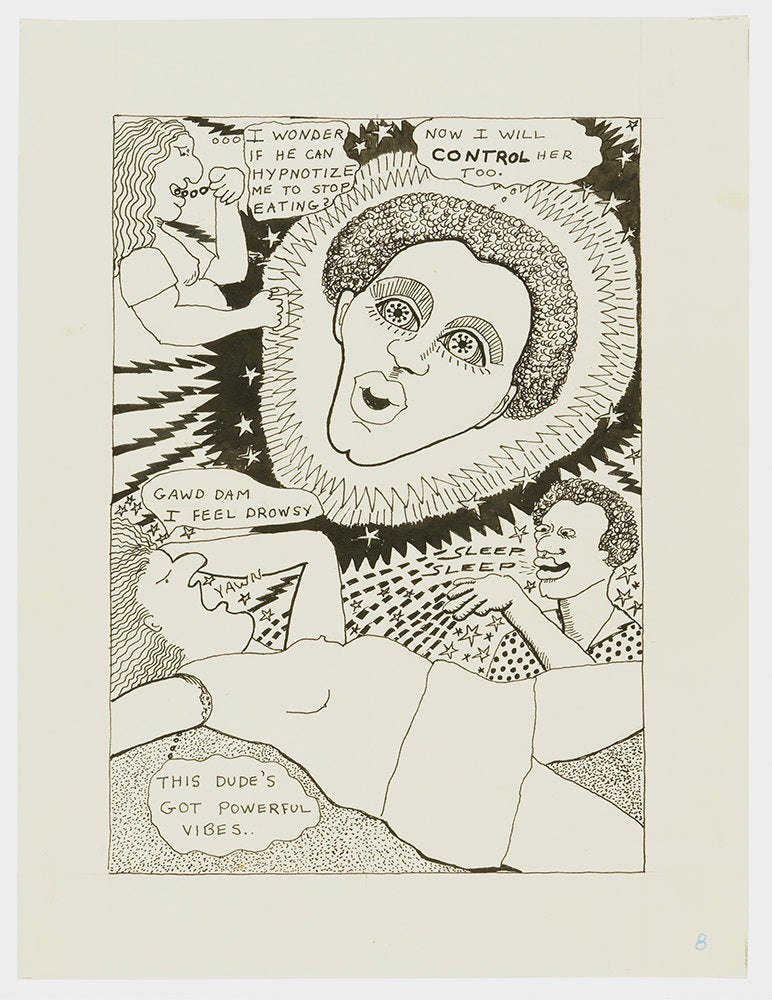
Being one of the few women comics in such a male-dominated field, do you think that helped or hindered your early career?
It was a period of revolution where everything was thrown into the air. There had never been woman cartoonists, in part because women had never thought of going into that field. As a woman, I thought I was really lucky. Most of the stories I drew got published. Most of the publishers were men and they were really okay. It was kind of a novelty that women were drawing comics and people were kind of intrigued by that. I arrived at the right moment, because it certainly wasn’t like that before or after.
How did it change after?
Women have produced such great stuff, so much better than what we were doing. Graphic novels are now considered a serious literary form, not a rebellious, underground art form. The quality of the work is really astounding. We started on a crude level. It’s become very refined.
Now self-deprecating autobiographies are such a source of strength and commiseration for women. Do you feel partially responsible for this?
To a degree, I think so. People like Alison Bechdel [”Fun Home”], Phoebe Gloeckner [”The Diary of a Teenage Girl”], Marjane Satrapi [”Persepolis”] ― a lot of those women read my work. I think it influenced them because it existed. I had nothing to look at, no references. They had some point of reference from which they could start. I’m really proud when I see that. Alison Bechdel is someone whose work reminds me a lot of how I express myself. I guess it comes down to something a lot of comics have in common — a bad childhood.
You’ve spoken in interviews about the difficulty of aging as a woman. Do you think the process is harder as an artist, as such a visual person?
I was raised in a place where all the superficial qualities are so important. You never escape that. I’m also somewhat of a media figure so I’ve appeared on TV, in photos, and you are forced to look at yourself. I’m vain! I do yoga, so I’m extremely fit for my age. I don’t feel old. All of those things affect how I age. I have good parts of me about it and bad parts.
I’ve done some stuff to my face, injections and all kinds of crazy shit. Whether it’s good or bad I can’t really say. For almost 69 years old, I think I look as good as I can expect. The funny thing is, I feel better about myself now then I did as a teenager. Back then I thought I was so ugly, but I was actually pretty cute!
What is your daily routine like these days?
I have a studio outside of my house that I share with a really great French artist. I just finished this book that’s going to come out, Love That Bunch. Now I’m doing drawings with marker pens that are totally crazy fantasies with people being devoured by nature. I’ve also been doing oil paintings, portraits. I like to go back to painting after I’ve done a lot of comic work. Comics are very structured. They’re very defined things. After I finish a long piece like that I have the urge to paint, to break out of that limited space. It’s very sensual, very meditative.
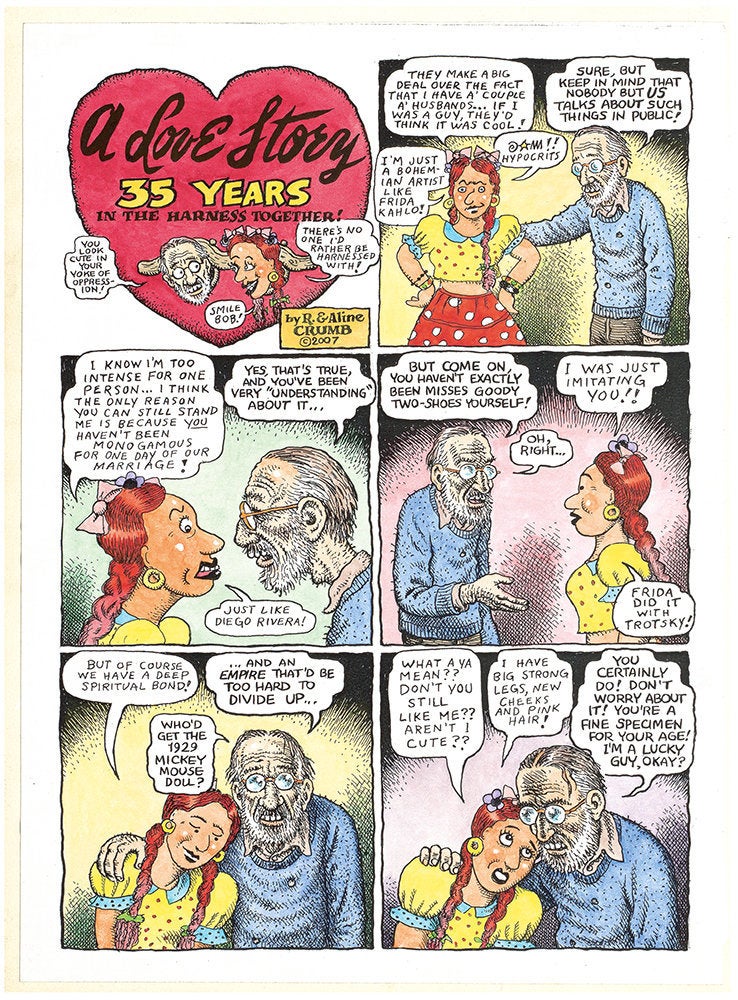
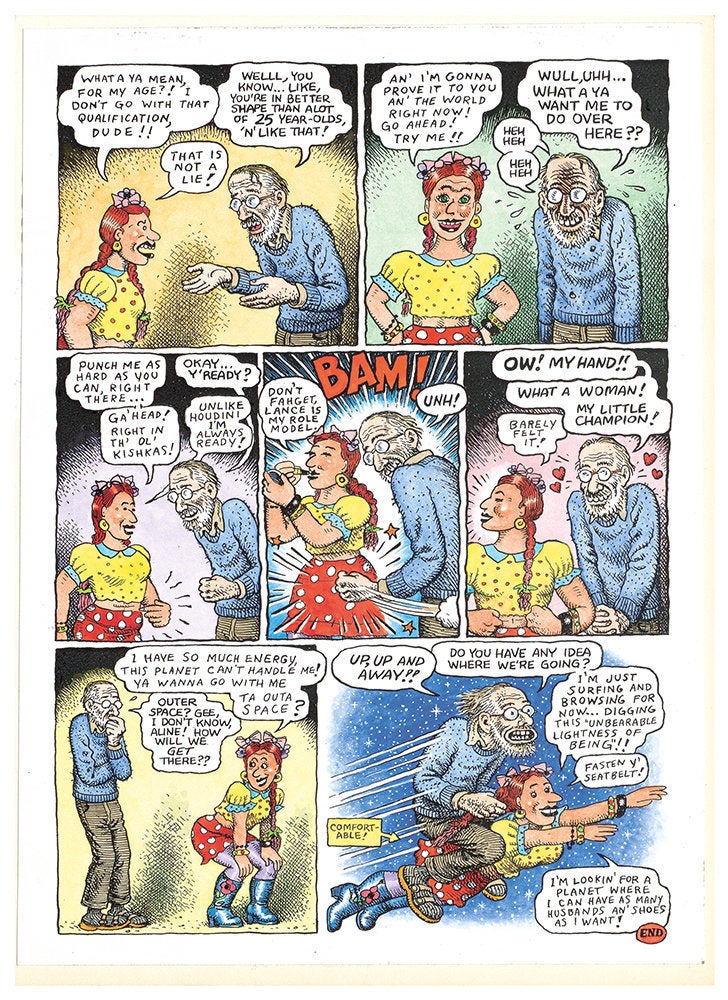
Do you feel compelled to make work that addresses what’s going on in the world, politically, right now?
I am certainly angry about what is happening in the world, but I am not directly a political cartoonist. I am not going to write a comic about Donald Trump but I might draw something related to what is going on. It has to be about how it affects me, how it hits us directly.
I can imagine it feels different being in Paris.
I was just in New York and my friends are just so depressed. I thought it would be bad, but it’s even worse than I thought. Steve Bannon, he’s pulling the strings. He has said things that are right out of Mein Kampf. It’s truly horrifying. Robert and I have had run-ins with The Observer, the paper run by Jared Kushner. I think he is really an evil bastard too, hidden by his cute boy face. Eventually we’ll have to do something.
There are strong feminist elements to your work and yet you don’t seem concerned with being politically correct. What do you think about contemporary feminism, or even contemporary liberalism, and its relationship to free speech?
I haven’t lived in America for 26 years. In France, there is a different ambiance. I am probably less affected by those thoughts than if I lived in New York or San Francisco. I’m a very powerful warrior. I am very committed to yoga. A lot of what I’ve done later in life is influenced by that. I have evolved on a spiritual level that has affected what I say and what I don’t say. More than politically correct or feminist ideology, I think I am more influenced by the teachings of yoga.
What are those teachings?
Don’t harm anything. I try not to harm anything. If I do tell a funny story, I try to put the blame or focus on myself. I try not to be mean. If I criticize something in society, it’s with the hope to make it better. I try to be the person that takes the blows. The yoga world has influenced me for the past 20 years. It is a powerful motivating factor. It helped me get through a lot. I wish I discovered it when I was younger.
Are you observant as a Jew?
No, not at all. But I’m totally culturally a Jew, in terms of humor and my way of writing and expressing myself. I love Jewish food. I love Jewish authors. I’m a real Jewophile, but my spirituality is extremely personal.
Your daughter, Sophie, is also a comic artist. Did you want her to follow in your footsteps?
All the Crumbs can draw. Sophie does amazingly beautiful, elegant drawings that are hard to describe. Very different than Robert and I. She’s a really great artist. She got so panned with her first works because she was our child. She was held up to impossible standards. She’s a very gifted human being. She definitely has something to say. But I wouldn’t say I encouraged it! Most people do not make a living making comics. We were incredibly lucky. We have always lived very simply. And now, Robert’s work is selling as fine art, which we never imagined.
If you could send a message to your younger self, what would you want her to know?
That the part of you that knows you’re okay and they’re all assholes was right. Just keep on being a warrior. That part of me was alive, even then. That warrior part of me got me through.
